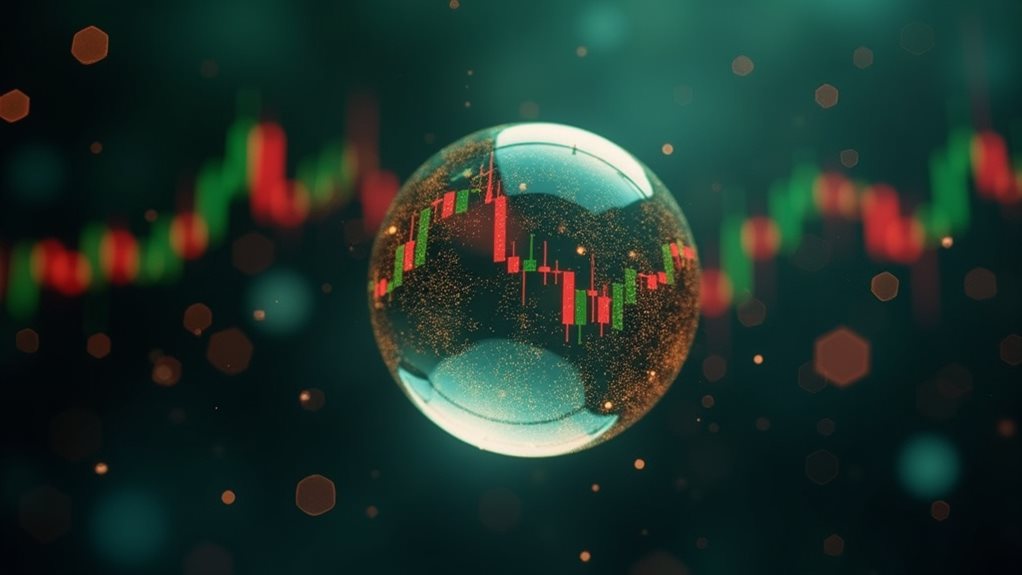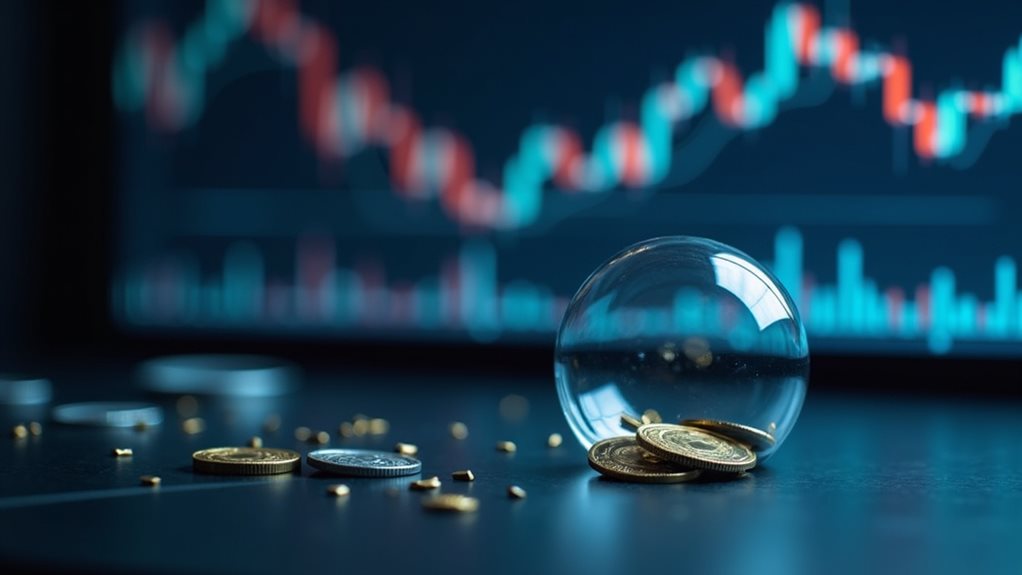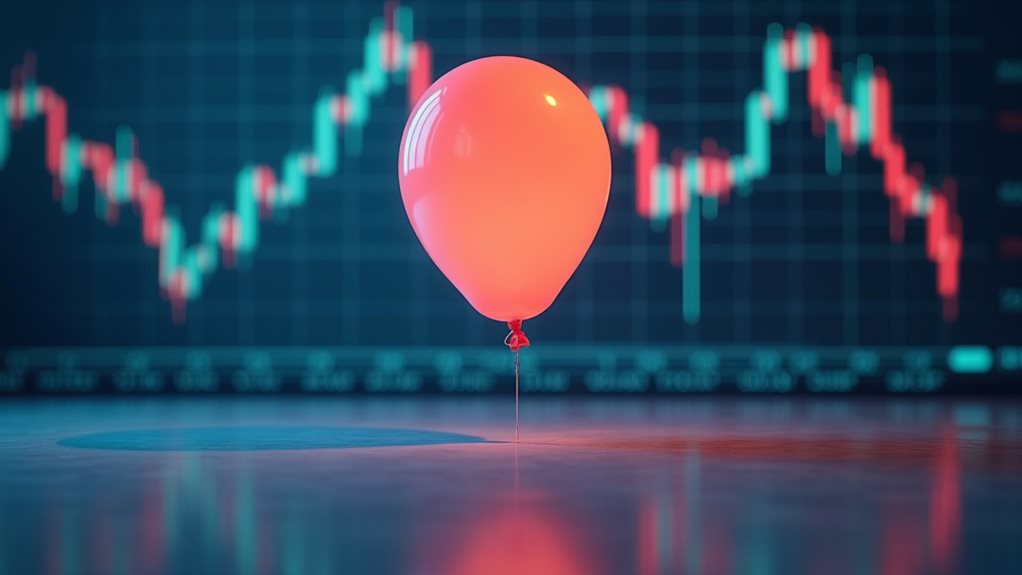Crypto bubbles are rapid price surges driven by speculative behavior and mass FOMO rather than actual value. You’ll see prices skyrocket, trading volumes explode, and social media go nuts with crypto memes. It’s when everyone and their grandma starts buying crypto because they think they’ll get rich quick. The media hypes it up, emotions run wild, and reality takes a backseat to greed. Just like any bubble, it’s all fun and games until it pops. There’s more to this story than meets the eye.
Understanding the Formation of Crypto Bubbles

While crypto bubbles might seem like random explosions of irrational exuberance, there’s actually a method to the madness.
It’s a perfect storm of speculative behavior, human psychology, and market dynamics coming together in one wild ride.
You’ll notice it starts with speculation – pure and simple. People aren’t buying crypto because they love the technology. Nope. They’re buying because they think someone else will pay more later. Classic. Investors need to be extra cautious since private key losses mean their assets could be gone forever.
Then FOMO kicks in. The media starts buzzing about incredible gains, and suddenly everyone’s jumping on board. No analysis needed, right? These cycles of enthusiasm have historically led to sharp price declines when the bubble finally bursts. The most dramatic example came in 2018 when cryptocurrencies collapsed by a staggering 80% from their January peak.
The lack of regulation doesn’t help either. Market manipulation? It happens.
And when you combine that with herd mentality, you’ve got a recipe for prices that shoot through the roof. Sometimes for no good reason at all.
Key Signs and Indicators of a Crypto Bubble

How can you spot a crypto bubble before it pops? Watch for these telltale bubble characteristics: prices shooting to the moon faster than a rocket ship, trading volumes going bonkers, and social media exploding with crypto memes. Yeah, it’s that obvious.
The clearest signs? Everyone’s suddenly a crypto genius. Your neighbor’s bragging about 1000x gains. Twitter’s flooded with outrageous price predictions. The Crypto Fear and Greed Index? Maxed out in “extreme greed” territory. Classic investor behavior when bubbles form. Media coverage often amplifies the frenzy by highlighting overnight millionaires. These price increases are driven by pure speculation rather than fundamental value. The current index reading of Fear and Greed at 25 suggests we’re experiencing the opposite end of market sentiment.
Look at the technical stuff too. RSI above 70 for ages? Not good. Trading volume charts looking like Mount Everest? Red flag.
And when TikTok teens start giving crypto advice while Google searches for “Bitcoin” hit all-time highs – well, you know what that means. Bubble alert!
How Crypto Bubbles Impact Market Psychology

Crypto bubbles mess with your head – big time. When prices surge, you’re swept up in a frenzy of greed and FOMO that’ll have you checking your portfolio every five minutes. Yeah, we’ve all been there.
The emotional volatility is intense. Fear and excitement ping-pong through the market like a caffeinated squirrel. One day you’re riding high on dopamine, watching those green candles. The next? Pure panic as everything crashes. Inexperienced investors often rush in based purely on trending excitement and hype. Conducting thorough market research can help you stay grounded when emotions run high.
Here’s the kicker: herd mentality makes it worse. You’ll watch others getting rich and jump in without thinking.
Social media hype, celebrity tweets, your neighbor’s crypto success story – it all feeds the madness. Your brain starts playing tricks, ignoring red flags while confirmation bias whispers sweet nothings about “going to the moon.”
The Role of Media and Social Sentiment

Since media coverage acts like rocket fuel for crypto bubbles, you’d better believe it’s a massive force behind price swings.
Media coverage doesn’t just report on crypto bubbles – it supercharges them, turning market movements into massive price avalanches.
The media influence can turn a ripple into a tidal wave, and social dynamics amplify everything. No joke – even negative press pumps up Bitcoin returns during bubble periods. Monitoring these trends using advanced analysis tools helps traders spot potential bubble formations.
You’ll see it everywhere. Reddit buzzing. Google trends spiking. Social media exploding with crypto chatter. It’s a perfect storm of hype and FOMO. Emotional decision-making leads to fragile price increases that can collapse at any moment. With market volatility reaching new heights in late 2024, these bubbles became even more pronounced.
And guess what? The tone doesn’t matter. Positive, negative – it all feeds the frenzy.
But here’s the kicker: when bubbles burst, media coverage flips faster than a crypto trader’s portfolio.
Suddenly it’s all doom and gloom, regulatory concerns, and “I told you so” headlines. Classic media circus.
Welcome to the wild world of crypto sentiment.
Risk Management During Bubble Periods

When markets go bonkers during crypto bubbles, you’d better have your risk management game on point. It’s not rocket science, but it sure isn’t child’s play either. Your first line of defense? Risk assessment. Yeah, boring stuff – but it works. Historical data shows that speculative behavior increases during these periods. Market recoveries take time, so patience is crucial for long-term success.
Today’s Web3 initiatives dominate investment flows in the crypto space. Smart investors don’t put all their crypto eggs in one basket. They’re spreading investments around, using hedging strategies like options and stablecoins. When prices start doing the moonwalk, they’ve got stop-loss orders ready to catch them if they fall.
Because let’s face it – markets can turn faster than a teenager’s mood swing.
Some folks think they can time the market perfectly. Good luck with that. The real pros are diversifying, monitoring market trends, and keeping some dry powder (that’s cash, by the way) for when things get ugly.
Learning From Historical Crypto Bubbles

Looking back at crypto’s wild history, you’ll notice one thing keeps happening over and over – bubbles. From Bitcoin’s early days trading for pennies to its recent $90,000 surge, these market cycles are like a broken record.
Historical comparisons show the same pattern: massive speculation, followed by brutal reality checks. The DeFi boom in 2020 saw Total Value Locked grow explosively from under $1 billion to over $15 billion. Today, with 106 million holders globally, Bitcoin leads the pack in market dominance.
Want to understand bubble dynamics? Check out 2017’s ICO mania – companies raising billions with nothing but promises. Or 2021’s institutional frenzy pushing Bitcoin to $68,000. Spoiler alert: it didn’t end well.
Each bubble has its own special flavor. Mt. Gox’s manipulation in 2013, the ETF hype of 2024, endless FOMO-driven rallies. Take LUNA’s collapse that sparked a massive market pullback in 2022.
But here’s the kicker – they all end the same way. Sharp corrections. Heavy losses. Reset buttons smashed.
History really does rhyme in crypto.
Strategies for Navigating Crypto Market Cycles

Steering through crypto’s rollercoaster cycles isn’t exactly rocket science – but it’s close. Your trading psychology better be iron-clad, because these markets don’t care about your feelings. Period. The market tends to follow predictable phases from bottom to top.
Successful investors have figured out some pretty clever accumulation strategies during different market phases. Let’s be real – most people absolutely stink at timing this stuff. Understanding when to take positions during bull and bear phases is critical for long-term success. With institutional adoption accelerating through ETF approvals and BlackRock’s initiatives, the playing field is evolving rapidly.
- Dollar-cost averaging keeps you sane when prices go bonkers
- HODLing through storms (yeah, it’s actually a legitimate strategy)
- Active trading – for those who enjoy sleepless nights and constant anxiety
- Risk management – because nobody likes losing their shirt
The smartest players watch market cycles like hawks, adapting their approach as sentiment shifts. Sometimes that means buying when everyone’s panicking, sometimes it means sitting on your hands when others are euphoric.
Not exactly comfortable, but that’s crypto for you.
Frequently Asked Questions
How Long Does the Average Crypto Bubble Typically Last Before Bursting?
You’ll typically see crypto bubble durations last between 1-2 years before bursting, though market fluctuations can shorten or extend this timeframe depending on speculative conditions and investor sentiment.
Can Crypto Bubbles Occur Simultaneously Across Different Blockchain Networks?
Yes, you’ll find that crypto bubbles often occur simultaneously across networks due to cross chain dynamics and investor sentiment. Market-wide bubble synchronization happens when speculation and hype affect multiple blockchains at the same time.
What Percentage of Investors Usually Recover Their Losses After Bubbles Burst?
You’ll find limited data on exact recovery rates, but your chances of loss recovery depend heavily on investor psychology, market timing, and diversification strategies. Most experienced investors recover better than newcomers.
Do Traditional Market Bubble Patterns Directly Correlate With Crypto Bubble Patterns?
While you’ll notice some traditional asset correlation in market behavior, crypto bubbles often follow their own extreme patterns. Market sentiment analysis shows crypto’s higher volatility and faster cycles compared to traditional bubbles.
How Do Institutional Investors Typically Behave During Crypto Bubble Formations?
You’ll notice institutional sentiment starts cautiously, then gradually increases as confidence builds. Major firms enter strategically, avoiding retail FOMO, but they’ll still amplify market psychology through large-scale investments and conservative risk management.









